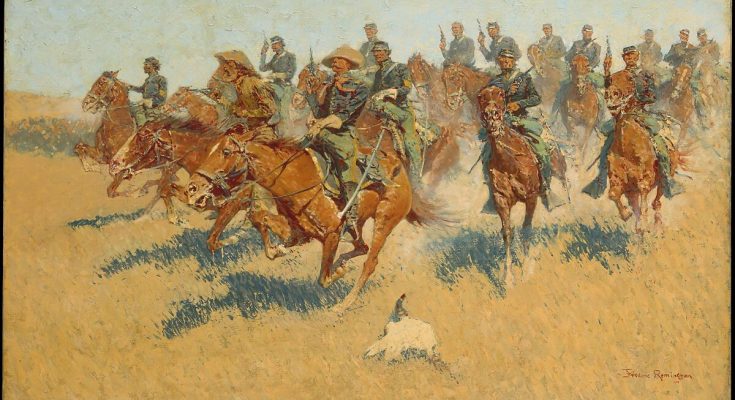Wild West painter Frederic Sackrider Remington is responsible for many of the images people think of when thinking of the settling of North America. While not having as large of a collection of work as some American Western painters, Remington’s Western paintings have undoubtedly become some of the most iconic, especially concerning the figures of the cowboy and the Indian.
Alongside the works of Charles Marion Russell, Frederic Remington’s paintings are a historical chronicling of sorts. They lovingly describe the daily lives of people living in America at the time, albeit in a highly dramatized and exciting fashion.
The symbolic icons presented in Remington’s art would go on to define the identity of the blossoming nation of the United States. They are a sentimental love letter to the humble men and women who tamed the wild land and made it their home.
Against The Sunset
One of the simplest and best ways to describe most of Frederic Remington’s paintings and sculptures is that they are larger-than-life representations of real events and people. For example, Remington painted many portraits of proud cowboys and lone Indians sitting heroically on their horses. It was one of his favorite topics to paint and is the theme for which he is best remembered.
Unlike many famous artists whose talent wasn’t recognized until long after their death, Frederic Remington’s Western paintings were widely acknowledged during his lifetime. In addition, he was one of the leading illustrators and chroniclers at the time.
His romanticized idolization of the American cowboy not only helped shape the identity of the common people but also elevated them to the level of icons. Take his painting titled Against The Sunset, for example. In the painting, a lone cowboy speedily rides through the land under the backdrop of the sunset. The rider and the horse have become synonymous and inseparable from the American identity.
The Bronco Buster
Another way of describing Remington’s art style is that they are similar to that of a comic book in their colorful composition, the daring poses of the characters, and the over-the-top escapades of the events portrayed. In most cases, Remington’s paintings are filled with dramatic action that you would find in a modern-day action or superhero movie.
One of the best examples of this is his series of paintings and sculptures depicting a cowboy taming a wild horse. These iconic works of art dramatically describe the common yet dangerous practice of breaking an untamed horse in and succumbing it to the will of the rider so that it can be
Of all the images associated with the Wild West, the Bronco Buster gripping tightly to the ferocious beast as it leaps through the air would become one of the most iconic images in American culture and is still in popular use to this very day.
A Brush With The Redskins
Speaking of action movie scenes, you can’t talk about famous western paintings without mentioning the high-stakes shootouts and high-speed horse chases for which the genre is well-known and beloved.
The Spaghetti Western movie genre owes a great deal to painters like Remington for much of its inspiration and subject matter. More than just painting these scenes, though, Remington actually lived the life of a real cowboy, and even though his paintings are dramatisations, for the most part, they stem from true events.
In the painting A Brush With The Redskins, three cowboys are pinned down behind a tree, with only their rifles to stand between them and their deaths. Remington composed many high-octane paintings such as this, which are worth viewing. In regards to the name “Redskins”, it was a derogatory term used to describe the Native American Indians.
Fire-Eater Raises His Arms To The Thunderbird
Much of Frederic Remington’s art, especially in the latter part of his career, features scenes and events from the Native American perspective. Frequently drawings of Native Americans were used as a way to depict these people as barbaric and describe them as little more than savages.
This couldn’t be further from the truth. On the one hand, the drawing of the Indian known as Fire-Eater can be seen as little more than the depiction of an archaic Indian ritual; the drawing is also filled with symbolism and perfectly describes a people’s pride and traditions.
When we learn more about Remington artist, we see a deep sympathy for the plight of the Indian and an even deeper respect for their culture and ways of life.
The Outlier
In the final years of Remington’s life, he became increasingly interested in Native American culture as an artistic topic of inspiration and dedicated dozens of paintings and drawings to this unique group of people.
Much of his later artwork is also layered with a much deeper level of poignance and emotion than his earlier work. Regarding the Native Americans, there is a sense of sympathy, and they are depicted with the same iconic grace as his cowboy paintings.
One of the only Impressionistic paintings Remington ever painted, The Outlier is among the artist’s most significant works. The faded figure of the Indian rider with the sun at his back symbolizes the twilight of the Native American way of life. It leaves the viewer with an impression of sadness while, at the same time, empathy for this once proud race of indigenous American people.
Conclusion
For Frederic Remington, the artist, the motivation of his paintings was to depict and dramatize the gritty day-to-day affairs of life in the Wild West. For Frederic Remington, the cowboy, though, his paintings describe the qualities and characteristics it took to survive and thrive in the harsh and unforgiving land.




